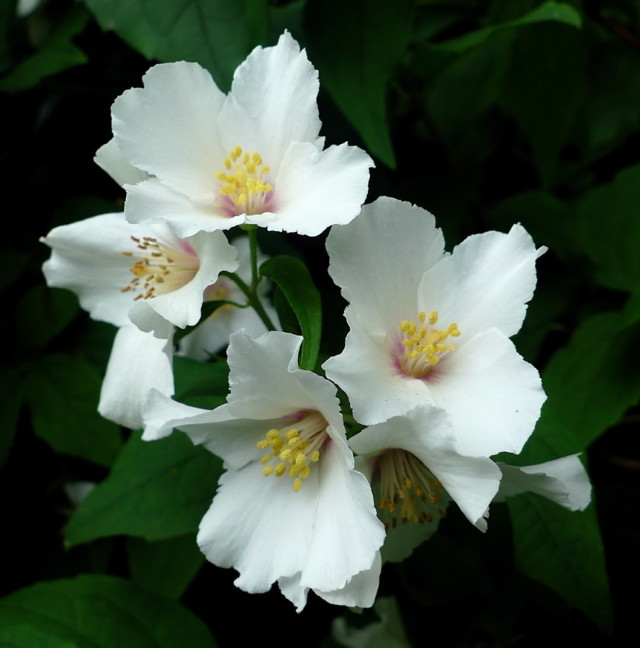Mock Orange: Tender but Tough

The flowers of Philadelphus x lemoinei ‘Belle Etoile’ (mock orange) have a charming little purple center. But only in cool weather. When the weather heats up, the flowers open pure white.
Mock orange (Philadelphus ) surely tops my list of the world’s most devastatingly delicious flower scents. It’s sweet but not cloying; penetrating yet in no way nauseating, as some intense flower-fragrances reportedly are to certain unfortunate souls. If you’re a connoisseur of scent, you’d say it smells a lot like citrus flowers, which may help explain the common name.
Just so you know, the common name "mock orange" can refer to several other plants including Pittosporum tobira and even "Mexican mock orange" (Choisya ternata ). So if you’re ever asking for it at a nursery, use the scientific name (Philadelphus ) if you run into any questions.
Philadelphus has been flowering in my garden for a couple of weeks but only today did I pick branches to bring inside. Now, my entire house is filled with this most luxurious, penetrating fragrance. If you love scented flowers, there’s just no good reason to be without this shrub.
You don’t even really have to make room for it in your garden. It’s one of those things you can plant in an out-of-the-way corner and – once established – it will bloom, almost no matter how little water or sunlight it receives. Of course, deep shade is not its friend, but mine’s planted in a most difficult spot, on the north side of a 30-foot English laurel hedge, and it still flowers its little heart out. Granted, it leans, but at least it flowers abundantly enough for me to pick armloads for bouquets! My next-door neighbor also has a very old, established Philadelphus planted in a totally neglected thicket… although goats ate it down to the ground a few years ago, his Philadelphus has since clambered its way through a tangled shrubbery and the top is in sun again, flowering merrily and sending its glorious fragrance wafting throughout my back garden.
Clearly, Philadelphus are tough, tolerating shade and quite a bit of drought once established. For the most part, they are fairly unassuming in form and the leaves are pretty but unspectacular. (Unless you have the gold-leafed form, which is dazzling.) The shrubs range in height from short types (about 3’ tall and bushy) to nearly 20’ tall for very old, established shrubs. The old-fashioned, tall types have an arching, umbrella-like form. Most types that are hardy for us are deciduous (drop their leaves in winter) but more southerly species can be evergreen.
All have glistening white flowers ranging from tiny, starry little things (four-petalled) to large, bouffy double blossoms.
There are some 60 species native to North and Central America, Asia and Southeastern Europe, as well as many, many cultivars including some old-fashioned forms bred in France in the 19th century. Here are some species and cultivars to look for:
Philadelphus x lemoinei ‘Belle Etoile’ – a medium-sized cultivar (about 6-8’ tall and wide) with nearly 2-inch diameter, single white flowers with a violet base. Intense fragrance.
Philadelphus coronarius ‘Aureum’ – a gold-leafed form with single white flowers. The gold leaves stay wonderfully bright all season. In a very sunny, hot spot, foliage can burn a bit so try it in full sun with summer irrigation or provide afternoon shade if it’s kept on the dry side. Reaches approximately 6-10’ tall and wide.
Philadelphus coronarius ‘Variegata’ – white-variegated foliage and typical pretty white, fragrant flowers. Reaches approximately 6-8’ tall and wide.
Philadelphus ‘Virginal’ – a lovely, double-flowered form reaching about 8-10 feet tall and a bit less wide.
Philadelphus ‘Manteau d’Hermine’ – a double-flowered variety with smaller leaves and a small stature: only about 3’ tall and about 5’ wide. Definitely fragrant!
Philadelphus lewisii – this state flower of Idaho is also more broadly a Western native. It’s very drought-tolerant, growing on banks and hillsides throughout most parts of Oregon. Height ranges from 4-10’ tall and 6-12’ wide. Some local nurseries have been busy selecting garden forms from regional native populations: search Plant Lust for options.
Sources:
Gossler Farms Nursery
Forest Farm Nursery
Cistus Design Nursery
Dancing Oaks Nursery
